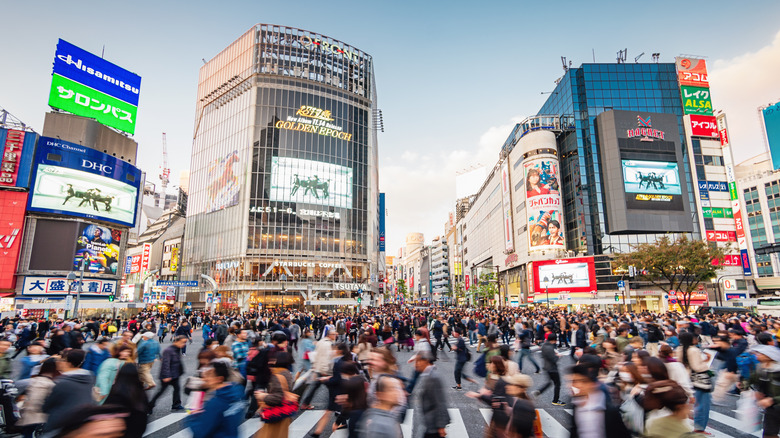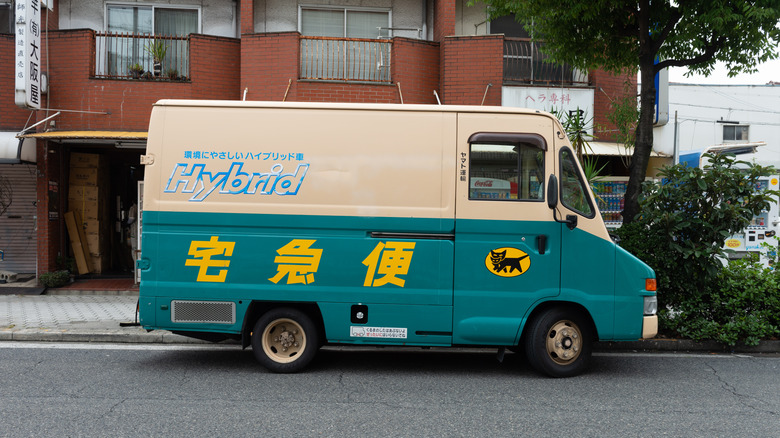The Clever Japanese Luggage Transfer System Travelers Promise Will Simplify Your Trip
Finally, your long-awaited trip to Japan is here. You step off your flight and pass smoothly through the airport, marveling at the efficiency. (Tokyo's Haneda and Narita airports were the fourth and fifth best in the world in 2024, according to Skytrax!) But then you realize it's 8 a.m. and you need to haul your suitcase across Tokyo to your hotel. Trust us, it's not going to be fun. That's where Japan's luggage transfer system (TA-Q-BIN) steps in, allowing you to send your bag on ahead, both from the airport and between cities.
Public transport is the best way to get around Tokyo, but it does come with some challenges. Namely, it can get pretty crowded, there are often a ton of stairs and no elevators in sight, and the subway and local trains don't usually have dedicated spaces for luggage. JR Pass warns, "An unwritten rule is that during rush hour, you should not bring any large items on local trains." Don't be that traveler!
Even on the Shinkansen (Japan's famous bullet train), there are complicated rules about the size and weight of luggage you're allowed to take and whether you need to make a separate reservation for your suitcase. You don't need to worry about any of that if you use a luggage forwarding service. You can travel light even if you didn't follow our top tips for packing light. The luggage transfer system is easy to navigate and can simplify your vacation to Japan.
How Japan's luggage delivery system works
The luggage transfer system in Japan is both easy to use and affordable. Before you do anything, though, check if your hotel can accept luggage! Then, choose one of the two main providers of luggage delivery: JAL/ABC and Yamato. Their websites are available in English, so you can book ahead online if you like.
However, you can also simply go up to one of their counters in many of Japan's major airports (including Narita and Haneda) and fill out a form there. You'll need a phone number in Japan. Many travelers use their hotel's number or a number from an eSim. Then, you wave goodbye to your heavy suitcase and head into the city, 40 pounds lighter. Alternatively, you can send your luggage from one hotel to another as you move between cities. Your hotel will be able to help you arrange this, though again, you'll need to check if your hotel allows luggage delivery — most do.
In terms of price, you're looking at a little under $14 from Narita Airport to Tokyo for smaller suitcases (maximum dimensions: 55 inches) to around $55 for a huge suitcase (up to 102 inches) with JAL/ABC. There is one big caveat to this incredible service, though. Same-day delivery is not always available, and you'll need to drop off your bag by a certain time if it is. That means you might need a small daypack with your essentials to keep you going overnight.
The best things about the luggage transfer system
Many travelers to Japan sing the praises of the country's luggage delivery system. Redditor u/serialbreakfast used Yamato and wrote in the r/JapanTravelTips forum, "Couldn't have been easier or more convenient." Worried about losing your luggage? One genius recommendation from AnteaterFit7156 is to use an AirTag to keep tabs on your bag (or one of the other effective ways to track your luggage). In the same forum, several users wrote about how helpful the hotel was when they used this service. Basically, the luggage delivery system is an essential travel hack when visiting Japan.
We understand that the idea of being without your large suitcase might put you off using this system. But it's always smart to pack some essentials in a carry-on in case the airline loses your luggage or you encounter a delay. If you're already doing this, packing the same few items for an overnight without your bag shouldn't be much trouble. Alternatively, you may want to use the service only in certain circumstances. For example, if you want to go into a rural area, we strongly recommend going without your large suitcase. For example, the Nakasendo Trail is a popular and historic area for hiking, but to get there, you need to take local trains and buses. Ship your suitcase ahead to your next destination.


